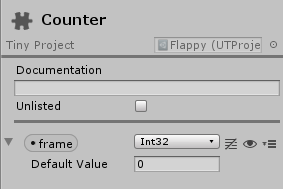Behaviours
If you have used Unity before, you may be familiar with the ubiquitous MonoBehaviour base class. In Tiny Mode, the ut.ComponentBehaviour attempts to replicate this pattern by providing a base class with OnEnable, OnUpdate, and OnDisable functions.
Note: This does not provide Object-Oriented programming features - rather, it is an ECS construct to provide a MonoBehaviour-like scheduling pattern and event model.
Here's a quick example.
Consider this custom component defined in the editor:

The following script uses the OnEntityEnabled, OnEntityUpdate, and OnEntityDisabled events to reset the frame value, increment it, and write status messages to the console:
// Scripts/FrameCounter.ts
namespace game {
export class FrameCounterFilter extends ut.EntityFilter {
entity: ut.Entity;
counter: game.Counter;
}
export class FrameCounter extends ut.ComponentBehaviour {
data: FrameCounterFilter;
OnEntityEnable(): void {
console.log("FrameCounter enabled");
this.data.counter.frame = 0;
}
OnEntityUpdate(): void {
let frame = this.data.counter.frame + 1;
this.data.counter.frame = frame;
console.log(`frame ${frame}`);
if (frame == 5) {
this.Disable(this.world, this.data.entity);
}
}
OnEntityDisable(): void {
console.log("FrameCounter disabled");
}
}
}
When run, the console outputs:
FrameCounter enabled
frame 1
frame 2
frame 3
frame 4
frame 5
FrameCounter disabled
When extending ut.ComponentBehaviour, you must:
- Define exactly one ut.EntityFilter field. In the example above, this is the data field.
- Define at least one standard method
- OnEntityEnable: called once when an entity matching the filter is initialized or becomes enabled.
- OnEntityUpdate: called every frame when an entity matching the filter is enabled
- OnEntityDisable: called once when an entity matching the filter becomes disabled
You can also use the ut.executeAfter and ut.executeBefore decorators to control the execution order between behaviours. However, since behaviours come with implicit scheduling, you can't schedule behaviours against individual systems or fences.
The OnEntityEnable event methods are executed before OnEntityUpdate, which are executed before OnEntityDisable. For example, if you have 2 classes of ComponentBehaviour: A and B, with B scheduled after A, and with behaviours defining all supported behaviour methods, the execution order would be:
- A.OnEntityEnable
- B.OnEntityEnable
- ut.Shared.InputFence
- ...
- ut.Shared.UserCodeStart
- ...
- A.OnEntityUpdate
- B.OnEntityUpdate
- ...
- ut.Shared.UserCodeEnd
- ...
- ut.Shared.PlatformRenderingFence
- A.OnEntityDisable
- B.OnEntityDisable
Extending ut.ComponentBehaviour gives you:
- Automatic behaviour state management per entity. No need to create extra components manually to track initialized or enabled states.
- Automatic scheduling of the supported event methods: OnEnable happens before OnUpdate, which happens before OnDisable.
At runtime, exactly one ut.ComponentBehaviour instance is created per behaviour type. You can access this instance by using the Instance property of any behaviour type.
Note that using ut.ComponentBehaviour is not free - it comes with a small performance overhead. If state management is not required, or if you need to iterate over multiple sets of entities within a system, prefer ut.ComponentSystem.